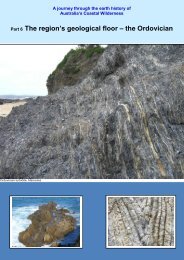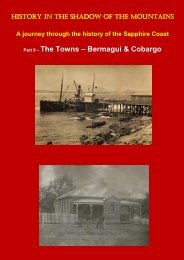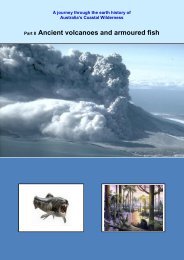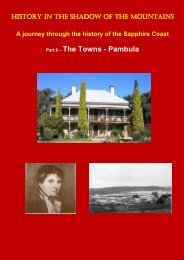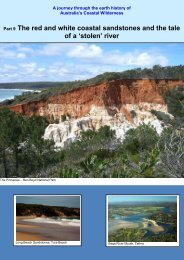2 The story of Granite and Bega Cheese - Sapphire Coast
2 The story of Granite and Bega Cheese - Sapphire Coast
2 The story of Granite and Bega Cheese - Sapphire Coast
You also want an ePaper? Increase the reach of your titles
YUMPU automatically turns print PDFs into web optimized ePapers that Google loves.
took place l<strong>and</strong>wards <strong>of</strong> the plate boundary, the so-called Palaeo-Pacific oceanic<br />
trench, with the oceanic plate sliding under (subducting beneath) the thick<br />
Gondwanan continental crust. As the oceanic plate sank, under increasing<br />
temperature <strong>and</strong> pressure <strong>and</strong> reactions with water saturated sediment, the rock<br />
materials melted <strong>and</strong> then rose like huge hot air balloons up through the crust (the<br />
plutons).<br />
If such molten rock, or magma, reaches the surface it can form explosive <strong>and</strong>esite<br />
volcanoes that are common today around the Pacific Ocean ‘ring <strong>of</strong> fire’ (actually a<br />
series <strong>of</strong> tectonic plate boundaries). If the magma cools below the surface, it forms<br />
granite – a generic term that covers a wide range <strong>of</strong> silica rich igneous rocks.<br />
Variations in chemical composition give granites their diverse colours <strong>and</strong> textures<br />
that distinguish one pluton from another. <strong>The</strong>se variations make a diversity <strong>of</strong><br />
building stones. Examples <strong>of</strong> this diversity are:<br />
<strong>The</strong> <strong>Bega</strong> granites are similar in appearance to number 3, with dominance <strong>of</strong> the<br />
white form <strong>of</strong> feldspar rather than the pink form.<br />
Igneous rock (from the Latin igneus meaning <strong>of</strong> fire) is one <strong>of</strong> the three main rock<br />
types, the others being sedimentary <strong>and</strong> metamorphic. Igneous rock is formed<br />
through the cooling <strong>and</strong> solidification <strong>of</strong> magma or lava. Igneous rock may form<br />
either below the surface as intrusive (plutonic) rocks or on the surface as extrusive<br />
(volcanic) rocks. (Wikipedia)<br />
Driving south from Moruya, you can see fine exposures <strong>of</strong> the granite in the road<br />
cuttings along the highway.<br />
<strong>Granite</strong> breaks down easily to produce the rich soil beloved by farmers, <strong>and</strong> a<br />
l<strong>and</strong>scape <strong>of</strong> gently rounded hills. Right through the region almost all <strong>of</strong> the dairy<br />
farms producing the famous <strong>Bega</strong> <strong>Cheese</strong> are on granite based soils, identified by<br />
the granite boulders dotted across the paddocks. <strong>The</strong>se boulders are easily seen




